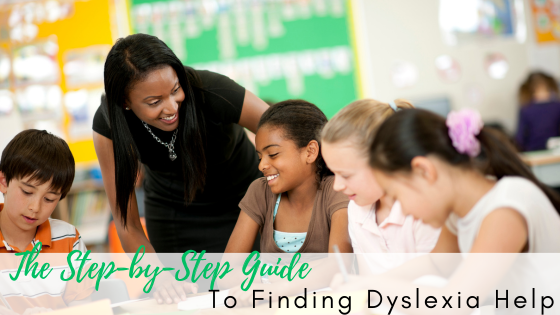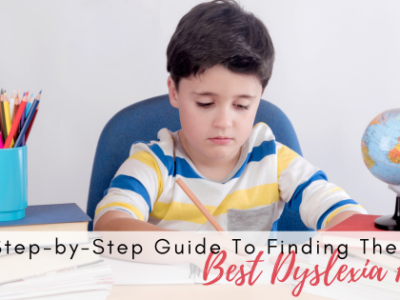
The Step-by-Step Guide To Finding Dyslexia Help
Have you embarked on a journey to seek help for dyslexia? There is so much to learn. Some estimates suggest that 20% of the U.S. population is affected by dyslexia. Fortunately for students who struggle with reading, there’s ongoing research around the importance of identifying the signs of dyslexia early. Early intervention and evidence-based programs can help to improve reading skills and success rates for children with dyslexia. There’s more good news: With the right kind of support and targeted interventions, students with dyslexia have the ability to become strong readers and learners. Despite challenges, there is plenty of potential for children with dyslexia to thrive and excel. Read on to learn more about the step-by-step guide to finding dyslexia help.
- Look for the signs. As a parent, you’re busy with the daily care of your child, and there are a lot of details to take care of in a day. As a parent, it is also important to make time to connect with your child and to look for some of the common signs of dyslexia that may surface in your child’s everyday life. These include things like having difficulty with reading and sounding out words, struggling with spelling, and having a hard time following written instructions. The earliest signs may be trouble rhyming or learning the alphabet, mispronouncing words and a general disinterest in reading.
- Write it down. So often, it’s easy to dismiss minor hiccups or issues that children face on a daily basis. However, when there are consistent problems that you notice your child struggling with, be sure to make a note of it. Documenting observations of when and how your child struggles—with reading or other academic skills—will point to how these issues impact daily life; documented details like this can help provide a detailed overall picture of your child’s areas of difficulty. This can be helpful when you work with teachers or other professionals.
- Talk to your doctor. Pediatricians and nurses check up on children at their annual well visits, and most doctors want to know more about the whole picture of health for your child. While it is not the specialty of pediatricians to diagnose dyslexia in patients, they can often help to rule out other medical conditions that could be affecting your child’s struggles in the classroom. Medical providers are able to offer resources, recommendations, and referrals for children who may need further evaluation.
- Connect with teachers. Whether your student is a preschooler, grade schooler, or in middle or high school, it is important to open the lines of communication. You can request a meeting or send e-mail correspondence to discuss concerns about your child’s reading development. You can share notes from any documentation and observations you have. While your child’s teacher can be a great resource, they are not infallible. If you feel that something is wrong, be an advocate for your child. Early intervention is key to overcoming dyslexia — this is not the time to “give it more time.”
- See about school-based support. The Individuals with Disabilities Education Act (IDEA) ensures that students get a free and appropriate education, no matter their level of ability. That said, your student might be eligible for an Individualized Education Program (IEP), which can be tailored to help address dyslexia. Many schools also have professionals like reading specialists or interventionists who are trained in supporting students with dyslexia.
- Look into testing. Sometimes, testing can really help to narrow down exactly what struggles a student is facing. You can talk to a teacher or other professional about doing a dyslexia evaluation. You may be pointed in the direction of a screening test or a formal evaluation by a qualified specialist.
- Check out some available resources online. The National Center for Learning Disabilities (NCLD) provides a lot of great information about dyslexia. Some other good website resources include: The International Dyslexia Association and Understood. In addition, Dyslexia on Demand offers a great resource guide for families who are dealing with dyslexia. Plenty of different sites provide great information on advocacy, education, and laws.
- Become an advocate. Whether you are working with teachers or therapists, being part of the process to help your student is essential. By staying informed and connected, you will be the best advocate for your student.
- Get more support. When it comes to helping a student with dyslexia, you can’t always do it all on your own. Finding additional support outside of school might be the best option. Consider working with a dyslexia professional who can provide individualized instruction and support outside of the classroom. A Certified Academic Language Specialist (CALT) is an ideal fit for students with dyslexia. At Dyslexia on Demand, CALTs work one-on-one or in small groups with students, and programs are personalized for the progress of each student.
Are you on the lookout for personalized dyslexia help for your child? Reach out to the experts at Dyslexia on Demand to learn more about dyslexia therapy. You can discover what a CALT can do to help your student to overcome his or her learning struggles. The mission of Dyslexia on Demand is to make dyslexia therapy available for all students. When you choose dyslexia therapy at Dyslexia on Demand, you are choosing the best dyslexia help for your student.







